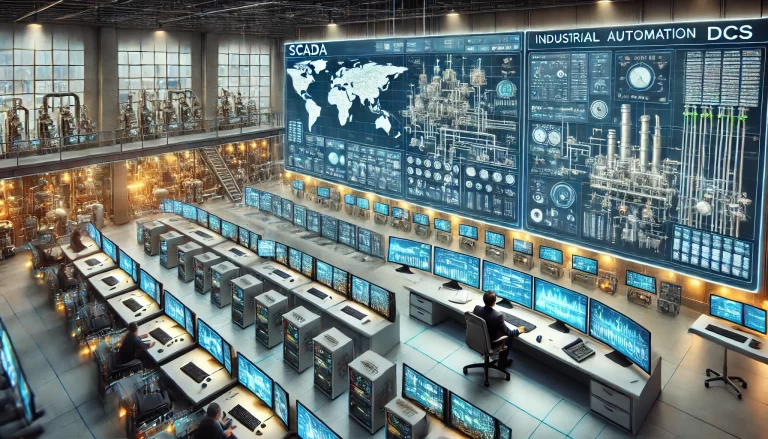In modern Distributed Control Systems (DCS), grounding is a critical aspect of ensuring reliable operation and minimizing interference. However, there are differing practices between thermal control (instrumentation) systems and electrical systems. This article explores why thermal control systems prioritize single-point grounding, while electrical systems often employ dual-point grounding, and how these principles apply in practical scenarios.
1. The Basics of Shielding and Grounding in Cables
Shielded cables are widely used in industrial environments to reduce electromagnetic interference (EMI). They are designed with a shielding layer that protects signal integrity by deflecting or absorbing electromagnetic fields. However, how these shields are grounded significantly impacts their effectiveness.
- Single-Point Grounding: The shield is connected to the ground at one end only, typically at the control system’s cabinet.
- Dual-Point Grounding: The shield is grounded at both ends, at the equipment side and the DCS cabinet side.
Both methods have their merits, depending on the nature of the system and the type of interference present.

2. Why Thermal Control Systems Prefer Single-Point Grounding
2.1. Characteristics of Thermal Control Systems
Thermal control systems often deal with low-frequency signals, such as temperature, pressure, or flow data. These signals are sensitive to interference caused by grounding loops—undesired current paths formed when a shield is grounded at multiple points with differing ground potentials.
2.2. Single-Point Grounding for Low-Frequency Signals
- Minimizing Ground Loops: Single-point grounding ensures that the shield does not form a loop that picks up stray currents from differing ground potentials, which could induce noise in the signal.
- Practicality in Distributed Systems: In thermal control, instruments are often spread across a large plant, making it impractical to ensure uniform grounding conditions. A single-point ground simplifies the setup.
2.3. Key Implementation Guidelines
When using single-point grounding:
- Ensure the shield has excellent insulation to prevent accidental grounding at intermediate points.
- For multi-pair shielded cables, each pair should have an independent shield to avoid cross-talk between signals.

3. Why Electrical Systems Use Dual-Point Grounding
3.1. Characteristics of Electrical Systems
Electrical systems often transmit higher frequency signals, such as those in power circuits or control relays. At these frequencies, magnetic field-induced interference is a greater concern.
3.2. Dual-Point Grounding for Magnetic Shielding
- Enhanced Shielding Effect: When grounded at both ends, the shield can carry induced currents caused by external magnetic fields, effectively canceling out the interference.
- Trade-Off: Dual-point grounding is effective for high-frequency systems but can create issues if the ground potentials at the two ends are significantly different.
3.3. Risk of Ground Potential Differences
Ground potential differences can cause transient currents to flow through the shield, inducing noise in the signal wires. These effects must be carefully managed through robust grounding designs and low-impedance connections.

4. Balancing the Two Approaches
4.1. Standards and Guidelines
The difference in grounding practices between thermal control and electrical systems stems from their respective design standards. For instance:
- Thermal Control: Emphasizes single-point grounding to avoid noise in low-frequency signals.
- Electrical Systems: Often follow guidelines like the Relay Protection and Automation Design Code, which recommends dual-point grounding for shielding in high-frequency circuits.
4.2. Real-World Application in DCS Systems
In practice:
- All signal cables entering a DCS cabinet are typically grounded at a single point to avoid interference caused by potential differences.
- Electrical systems use dual-point grounding but ensure the ground grid is robust enough to minimize potential differences between grounding points.

5. Practical Recommendations and Case Examples
Example: Managing Interference in a Large Plant
In a plant where both thermal control and electrical signals coexist:
- Thermal Control Signals: Use single-point grounding at the DCS cabinet. For distributed instruments, maintain continuous shielding without grounding intermediate points.
- Electrical Signals: Ground both ends of the shield but ensure the grounding grid design minimizes potential differences.
Visual Aids
Diagrams illustrating the flow of interference currents in single- and dual-point grounding setups can help operators better understand the grounding principles.

6. Conclusion
Grounding and shielding are essential for minimizing interference and ensuring reliable DCS operation. The choice between single-point and dual-point grounding should be guided by the nature of the signals, the frequency of operation, and the plant’s grounding design. Understanding these principles and their practical implications will help engineers implement robust, interference-free systems.
